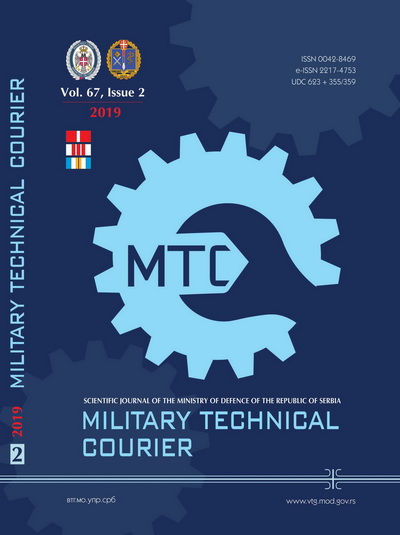Velocity of powder particles in plasma at low pressure
Abstract
Low pressure of inert gas in the vacuum chamber significantly affects the transfer of plasma particle velocity onto powder particles, residence time of powder particles in plasma and the kinetic energy of molten particles before the collision with the substrate. In addition to low pressure of inert gas in the vacuum chamber, the size and mass density of powder particles, together with plasma arc power, have the biggest impact on the average velocity of powder particles. To measure the velocity of powder particles in the vacuum chamber at low pressure, a laser speedometer is applied.The average velocity of molten powder particles V=s/t is calculated when the length of the path of powder particles that pass between two focus distances of the laser beam is divided by the time of particle passage between the two focuses. Measurements are done for vacuum chamber pressure, the values of which are usually from 6.7 to 80 kPa. The paper describes the relationship between the average velocity of Al2O3 and W powder particles and the vacuum chamber pressure, granulate distribution, mass density and plasma arc power. It was found that, for powder of lower mass density, the average velocity of particles can increase for 200 m/s with a decrease in chamber pressure.The effect of pressure on W particles of larger mass density is lower but still important, because a decrease in pressure increases the average velocity of particles up to 50%. Reducing plasma arc power reduces the maximum velocity of both types of powder particles.
References
Aebli, N., Krebs, J., Stich, H., Schawalder, P., Walton, M., Schwenke, D., Gruner, H., Gasser, B., & Theis, J. 2003. In vivo comparison of the osseointegration of vacuum plasma sprayed titanium- and hydroxyapatite-coated implants. Journal of Biomedical Materials Research, 66(2), pp.356-363. Available at: https://doi.org/10.1002/jbm.a.10508.
Ganvir, A., Curry, N., Govindarajan, S., & Markocsan, N. 2015. Characterization of Thermal Barrier Coatings Produced by Various Thermal Spray Techniques Using Solid Powder, Suspension, and Solution Precursor Feedstock Material. International Journal of Applied Ceramic Technology, 13(2), pp.324-332. Available at: https://doi.org/10.1111/ijac.12472.
Graziani, G., Bianchi, M., Sassoni, E., Russo, A., & Marcacci, M. 2017. Ion-substituted calcium phosphate coatings deposited by plasma-assisted techniques: A review. Materials Science and Engineering: C, 74(1), pp.219-229. Available at: https://doi.org/10.1016/j.msec.2016.12.018.
Hamatani, H., Crawford, W., & Cappelli, M. 2003. Optical measurements of plasma velocity and temperature in a low-rate, low-power LPPS system. Surface and Coatings Technology, 162(1), pp.79-92. Available at: https://doi.org/10.1016/s0257-8972(02)00565-0.
Mauer, G., Vaßen, R., Zimmermann, S., Biermordt, T., Heinrich, M., Marques, J.-L., Landes, K., & Schein, J. 2013. Investigation and Comparison of In-Flight Particle Velocity During the Plasma-Spray Process as Measured by Laser Doppler Anemometry and DPV-2000. Journal of Thermal Spray Technology, 22(6), pp.892-900. Available at: https://doi.org/10.1007/s11666-013-9940-9.
Mrdak, M. 2018. Transfer of heat and speed of plasma particles to powder particles in the plasma spray process at atmospheric pressure. Vojnotehnički glasnik/Military Technical Courier, 66(2), pp.415-430. Available at: https://doi.org/10.5937/vojtehg66-12942.
Muehlberger, E. 1974. A High Energy Plasma Coating Process. In 7th International Metal Spraying Conference, The Welding Institute, Abington, Cambridge, U.K., pp.245-256.
Smith, F.M. 1988. Laser Measurement of Particle Velocities in Vacuum Plasma Spray Deposition. In 1st Plasma – Technik – Symposium, Swicerland, Lucerne, May 18-20, pp.77-85.
Smith, M.F., & Dykhuizen, R.C. 1988. Effect of chamber pressure on particle velocities in low pressure plasma spray deposition. Surface and Coatings Technology, 34(1), pp.25-31. Available at: https://doi.org/10.1016/0257-8972(88)90085-0.
Smith, M.F., Hall, A.C., Fleetwood, J.D., & Meyer, P. 2011. Very Low Pressure Plasma Spray: A Review of an Emerging Technology in the Thermal Spray Community. Coatings, 1(2), pp.117-132. Available at: https://doi.org/10.3390/coatings1020117.
Young, E.J., Mateeva, E., Moore, J.J., Mishra, B., & Loch, M. 2000. Low pressure plasma spray coatings. Thin Solid Films, 377-378, pp.788-792. Available at: https://doi.org/10.1016/s0040-6090(00)01452-8.
Zhang, N., Zhu, L., Planche, M.P., & Coddet, C. 2012. In-flight particle characterization and coating formation of yttria-stabilized zirconia under low pressure plasma spray condition. In Thermal Spray: Proceedings from the International Thermal Spray Conference and Exposition, USA, Texas, Houston, May 21–24, pp.724-728.
Proposed Creative Commons Copyright Notices
Proposed Policy for Military Technical Courier (Journals That Offer Open Access)
Authors who publish with this journal agree to the following terms:
Authors retain copyright and grant the journal right of first publication with the work simultaneously licensed under a Creative Commons Attribution License that allows others to share the work with an acknowledgement of the work's authorship and initial publication in this journal.
- Authors are able to enter into separate, additional contractual arrangements for the non-exclusive distribution of the journal's published version of the work (e.g., post it to an institutional repository or publish it in a book), with an acknowledgement of its initial publication in this journal.
- Authors are permitted and encouraged to post their work online (e.g., in institutional repositories or on their website) prior to and during the submission process, as it can lead to productive exchanges, as well as earlier and greater citation of published work (See The Effect of Open Access).

